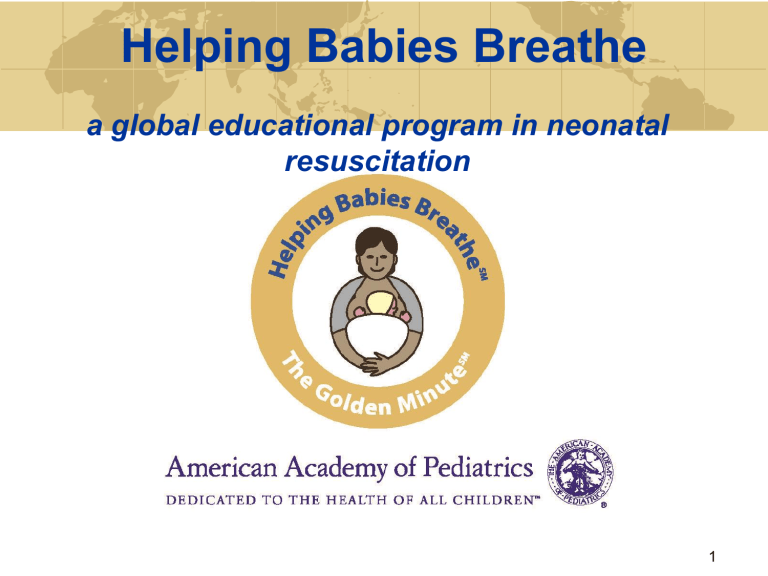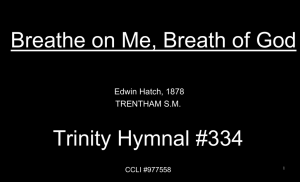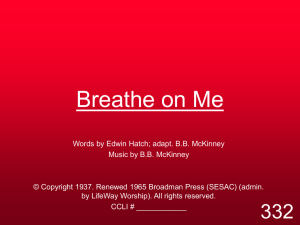Helping Babies Breathe: What makes it different?

Helping Babies Breathe a global educational program in neonatal resuscitation
1
Hel
p
ing Babies Breathe
Target of Helping Babies Breathe
1.02 million stillbirths due to asphyxia
830,000 neonatal deaths due to asphyxia
Lawn JE et al. IJGO 2009; 107:S5
3
Circumstances at Birth
Wall SN, et al. IJGO 2009; 107:S47
4
Need for help to breathe at birth
Assessment at birth and routine care
80-90%
Drying, warmth, clearing the airway, stimulation
Bag and mask ventilation
Chest compressions, medications
3-6%
< 1
8-10%
5
Evidence base and Evaluation
• Scientific evidence base
– International consensus on science (ILCOR)
– Revision every 6 years
• Harmonization with international health policy
– WHO technical expert review
– Delphi panel
6
Helping Babies Breathe
• World Health Organization
– Basic resuscitation guidelines (in revision)
– Hand washing
– Breastfeeding
– Context of ENC
Helping Babies Breathe
8
Action Plan
Plan
9
Helping Babies Breathe
Preparation for Birth
Identifying a helper and reviewing the emergency plan
Preparing the are for delivery
Hand washing
Preparing and area for ventilation and checking equipment
10
Helping Babies Breathe
Routine Care
Drying thoroughly
Keeping warm
Evaluating crying
Checking breathing
Clamping or typing and cutting the cord
11
Helping Babies Breathe
The Golden Minute
Positioning the head
Clearing the Airway
Providing stimulation to breathe
Evaluating breathing
Initiating ventilation
Ventilating with bag and mask
12
Helping Babies Breathe
Continued ventilation with normal or slow heart rate
Improving ventilation
Evaluating heart rate
Activating the emergency plan
Support Family
13
Evaluation
Formative Evaluation
Content/Methodology/Educational
• Kenya
• Pakistan
Helping Babies Breathe
• Training of Master Trainers
• Training of a facilitator and learners
Learner pair + neonatal simulator
6:1 learner-to-facilitator ratio
16
Graphic linkage of Action Plan, flipchart, learner workbook
17
Flipchart image for learner and instructional guide for facilitator
18
Peer learning/teaching
19
Case scenarios conducted independently by learner pairs
20
Helping Babies Breathe
• Course assessment
– All HBB training participant
– Master Trainers & Facilitators after teaching
• Knowledge assessment
– Multiple Choice Questionnaire (pre- and post-training)
• Skills and Performance assessment
– Bag-and-mask skills assessment (pre and post)
– OSCE A (post only)
– OSCE B (post only)
• Qualitative assessment
– Focus Group Discussions
21
Results
Helping Babies Breathe
(Likert’s scale) Facilitators
Training to lead a course
Course materials
I can help baby breathe
Group will help babies breathe
Kenya
5
4.8
4.85
4.75
Pakistan
4.73
4.3
4.55
4.9
23
Helping Babies Breathe
Learners
Course Content
I can use Action Plan
I can help babies breathe
Kenya
4.45
4.43
4.58
Pakistan
4.80
4.64
4.70
24
Knowledge Assessment
Facilitators
Learners
Pre
Kenya
20.5
Pass: 75%
14.0
2%
Post
Kenya
22.3
Pass: 95%
19.5
54%
Post
Pakistan
20.2
Pass: 82%
19.5
52%
T-test
P < .01
P < .001
25
Skills Assessment
Bag-and-mask ventilation skills
Master = 12/12 steps correct
Pre
Kenya
Post
Kenya
Post
Pakistan
Facilitators 2.0
Pass: 0%
10.5
Pass: 31%
11.8
Pass: 48%
Learners .17
0&
9.4
15%
9
17%
Item missed most frequently: “ventilate at 40 breaths per minute”
“watch for chest rise”
T-test
P < .00001
P < .00001
26
Performance Assessment
Objective Structured Clinical Evaluation (OSCE post-HBB training only)
OSCE A (11 items) pass = 3 critical items and 80% overall
OSCE B (22 items) pass = 9 critical items and 80% overall
Facilitators
OSCE A
Kenya
8.9
50%
OSCE A
Pakistan
8.36
100%
OSCE B
Kenya
19.3
70%
OSCE A
Pakistan
17.64
45%
Learners 9.1
Pass: 60%
8.32
Pass: 83%
15.8
Pass: 20%
15.6
Pass: 23%
27
Conclusions from Phase I
Helping Babies Breathe
Increases knowledge of immediate care at birth and interventions to help babies who do not breathe.
Improves bag-and-mask ventilation (BMV) skills.
Improves the ability of birth attendants in the resource-limited setting to manage both simple
(OSCE A) and complicated (OSCE B) cases of newborns who do not breathe spontaneously.
28
Helping Babies Breathe
Implementation Field Testing
India
Tanzania
Kenya
Bangladesh
29
Results India
30
Knowledge Assessment
HBB Trainers & Providers
31
Helping Babies Breathe
Deliveries
Live Births
Still Births
Deaths at Birth
Pre-Training
Oct 2009 – Mar 2010
4173
4046
124 (3%)
3
Post Training
Mar 2010 – Oct 2010
5427
5301
123 (2.3%)
3
32
Helping Babies Breathe
Body breathing at 1 minute
Resuscitation Required
Stimulation
Suction
Bag & Mask
Bag & Mask started < 1 minute
Pre Training n(%)
118 (2.8)
1218 (29.2)
666 (16)
1113 (26.7)
124 (3)
92 (2.2)
Post Training n(%)
266 (4.9)
645 (11.9)
491 (9)
594 (10)
219 (4)
144 (2.7)
33
Helping Babies Breathe
Conclusions
• Better recognition of babies not breathing at birth
• Still births decreased
• Neonatal deaths remained unchanged
• Need for specific resuscitation decreased
34
Helping Babies Breathe
Summary
• Program well received
• Improves knowledge
• Improves skills
• Clinical impact needs further study
35
Helping Babies Breathe
Sustainability
• Simple
• Evidence based
• Low-cost and effective
• Easy to integrate
• Hands on
• Empowers the learner
• Higher level of learning
• Promotes life long learning
36
Helping Babies Breathe
Babies acknowledge the support of
• American Academy of Pediatrics (AAP)
• United States Agency for International Development
(USAID)
• Laerdal Medical
• Laerdal Foundation for Acute Medicine
• Saving Newborn Lives (SNL)
• Eunice Kennedy Shriver National Institute of Child
Health & Human Development (NICHD)
• World Health Organization (WHO)
37
Thank You
Nalini Singhal, Calgary Canada
Millennium Development Goal 4
Under-5 mortality rate
Early neonatal mortality
Late neonatal mortality
Target for
MDG-4
1960 1980
Year
2000 2020
Lawn JE et al. Lancet 2005
Reduce under-5 child deaths 2/3 from 1990 levels by 2015
Global causes of neonatal death
UNICEF 2007
Lee ACC, et al. Int J Epidemiol (inpress)
The World of Physicians Working www.worldmapper.org 2002
41
The World of Physicians Working www.worldmapper.org 2002
42
Regional rates of neonatal mortality
UNICEF, State of the World’s Children 2009








